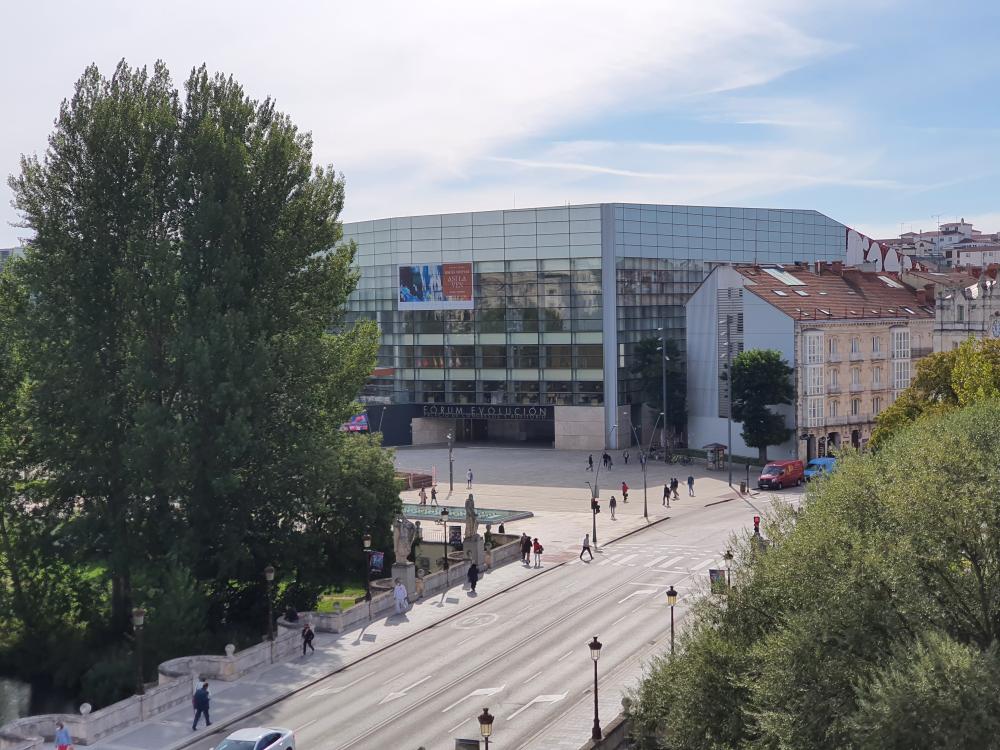The city grew beyond its walls and this route is punctuated by the many religious foundations with health and educative purposes, or the mansions that were built on the southern bank of the Arlanzón river. Nowadays, many of those buildings have been renovated, hosting new cultural infrastructures.
1. CHURCH OF LA MERCED
Built between 1498 and 1515 with the support of Francisco del Castillo and Leonor Pesquera, whose fine Renaissance sepulchres are preserved in the beautiful chancel of a temple that stands out due to its remarkable slenderness. The Renaissance cloister from the old monastery, work of Juan de Vallejo and the Gothic style church built by Simón de Colonia and Diego de Siloé still remain today. Its flamboyant style façade contains the coats of arms of the Castillo and Pesquera families. Its construction was an important focal point for the urbanisation of the dynamic district of Vega. After being disentailed during the 19th century and being used temporarily as a military hospital, the building was acquired in 1880 by the Jesuits monks, who built a new residence next to the temple.
2. SAN NICOLÁS COLLEGE (NOWADAYS, CARDENAL LOPEZ DE MENDOZA HIGH SCHOOL)
The old San Nicolas college is now the Cardenal López de Mendoza high school. Back in 1537 the construction of this building began, founded by the will of Cardinal Iñigo López de Mendoza. Throughout its history it has been home to the study of the arts and theology, as well as a hospital and a military station. This building is surprisingly well preserved and represents a good example of local Renaissance architecture in Burgos. The main façade stands out on the exterior, and the interior is organised around a tracery courtyard.
3. SAN COSME AND SAN DAMIÁN CHURCH
Located in the traditional neighbourhood of Vega, this temple is known for being one of the most beautiful of Burgos. Its restrained external aspect, with its elaborate facade by the local master Juan de Vallejo, contrasts with its beautiful and rich interior, whichmasterfully combines the characteristic volumes of the late Gothic period with the impressive beauty of its Baroque altarpiece from the 17th century. Thesepulchres of Catalina de Frías and her husband the forging master Cristobal de Andino are also worth seeing.
4. CONVENT OF SANTA DOROTEA
This monastery, run by Augustinian nuns, was established here at the end of 15th century with the sponsorship of Bishop Juan de Ortega. The main facade of its church, decorated with the coats of arms of the Catholic Kings, work of Simon de Colonia, is an interesting example of late Gothic art. The most important works of art are the tombs of the family of Juan de Ortega, of astonishing beauty.
5. ROYAL MONASTERY OF SAN AGUSTÍN
This monastery was one of the main pilgrimage centres of the city, which would leave all of its visitors speechless. Nowadays the most interesting part of the monastery is its wonderful cloister, that conserves 3 of its wings and can be seen from Calle Madrid.
6. CONCEPCIÓN HOSPITAL
Concepción Hospital was builtin the 16th century with the support of the brotherhood of La Concepción and the economic backing of the rich merchant Diego de Bernuy. From the very beginning it served as a pilgrims lodge and had nurses for both men and women. It is a Renaissance building featuring a facade from the 17th centurywith the image of the Conception and mighty columns in its north facade. This is where Santa Teresa de Jesús stayed. It was also the headquarters of the Faculty of Medicine at the end of the 18th century and served as a barracks for French troops during the Spanish War of Independence in around 1813.
7. CONVENT OF SANTA CLARA
This is a Gothic building built mostly during the 13th century that received the support of the influential Salamanca y Polanco family during the 16th century, enablingthe improvement and extension of the original building. In contrast to the exterior, which goes unnoticed, the interior of the convent shows a refined Gothic architecture that gathers together influences from the cathedral, in perfect harmony with the notable Baroque altarpiece of its main altar.
8. MUSEUM OF BURGOS
Located in two adjacent palaces, Casa Miranda and Casa de Íñigo Angulo, both of them examples of the local residential architecture of the Renaissance, this museum has a very rich regional art collection from different ages. From Palacio de Miranda we should highlight the front of its main facade decorated with heraldic coat of arms and its beautiful inner courtyard covering two floors. In Casa de Íñigo Angulo its main facade decorated with plant motifs and the coats of arms dedicated to fine arts must be seen.
9. HUMAN EVOLUTION MUSEUM – SIERRA DE ATAPUERCA PROMENADE- CONVENT OF SAN JOSÉ AND SANTA ANA
Located between Paseo de la Quinta and San Pablo bridge is the new Paseo de la Sierra de Atapuerca, connecting the convent of San José and Santa Ana, the last founding of Santa Teresa de Jesús with the complex of Human Evolution, that hosts the National Investigation Centre of Human Evolution, the Museum of Human Evolution and the congress hall Forum Evolución. This lovely space means the completion of a long-time dream for the city of Burgos: to be a meeting place of cultures and a bridge between the past and the future.

